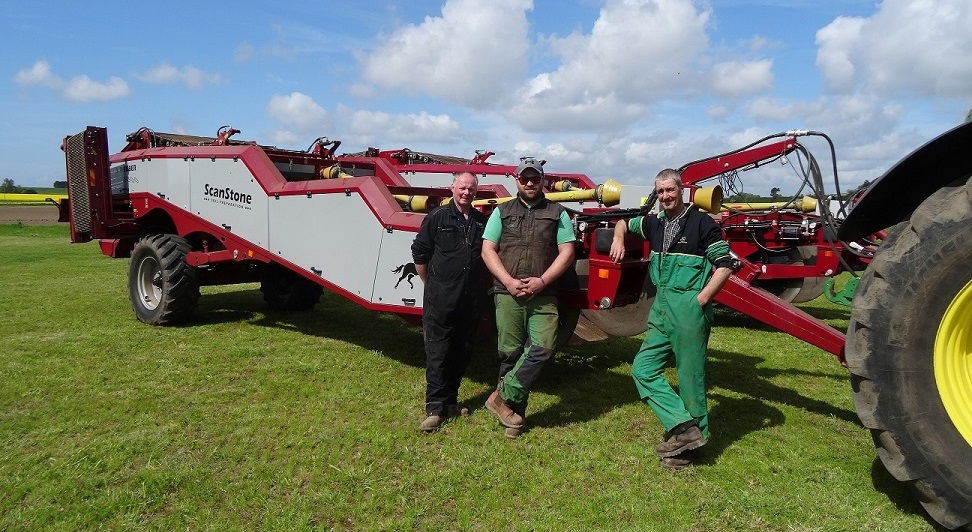Fairlie Fresh, Scotland
William and Alison Skea from ScanStone visited Fairlie Fresh, to see James Fairlie and his father Ian, and find out how they got on with their 2 new 5 Webber destoners after an uninterrupted season.
James and Ian Fairlie, who run the farm at Kirkton of Monikie were very impressed with the performance of the 5 Webbers, and Rab and Ian praised the machine, giving in-depth and constructive feedback which is invaluable to the R&D department at ScanStone’s base in Angus.
Coming away from 3 machines, Fairlie Fresh said they were able to make a saving while still achieving the same output in the same number of acres planted.
Rab and Ian commented that the machines were easy to pull with their 2 John Deere 6215R tractors, and there was no boost required throughout the season.
They were able to work both uphill and downhill and commented that they could cover area with the new 5 Webbers that they could not with their previous machines.
Ian Fairlie mentioned that having the extra 5th drop meant that a lot of areas did not need to be bed tilled, unlike the previous year, offering more flexibility and less cost. He said that they were able to rely on the performance of the destoners, regardless of soil conditions, and said that in a wetter year, the 5 Webbers would really be worth the investment.
Rab and Ian were very impressed with the new Chateau Bed Formers that they had on demo earlier in the season. They mentioned that the destoner followed the Chateau ridges perfectly, and the intake disks of the destoner were exactly where they needed to be to pick up all the soil, while missing any stone. The wheels of the destoner also fitted well into the ridges and prevented the destoner wandering unintentionally. The flatter bed was advantageous in a dry year like this season, as it kept in as much moisture as possible, while also offering an even intake and even wear across the width of the destoner, they said. The wider steeper bed left by the chateau ploughs meant that the destoner could work less deep and achieve a more than adequate amount of soil behind the bed, Ian remarked.
James said that he had never planted in headlands like it.
Comparing the machines to their predecessors, James commented on the soft drive which acted as a shock absorber on the road and reduced strain on both the tractor and machine.
Rab and Ian both commented that it was more comfortable when roading the machines from their farm at Kirkton of Monikie, up to Aberdeenshire where they also plant potatoes. The upgraded 8-stud commercial-style axle on the new 5 Webbers meant that road travel was safer, easier and with no
maintenance issues.
On their first journey to land 60 miles away, Rab and Ian mentioned that they stopped 3 times to check the temperature of the wheel hubs, but everything was as normal.
Ian Fairlie remarked that the bigger 405 R24 wheels seem to fit perfectly in the rows, and their wider width meant less compaction, while being able to flatten the stones in the bed. The 8-stud upgraded drawbar with pick-up hook, meant hitching to and from the tractor was effortless. Rab mentioned that there was a better clearance at the front of the machine as well.
Working with a longer machine, James was initially unsure about the ease of turning on the headland, however with the increased steering angle on the new 5 Webber compared to his older machines, the extra length did not pose any issue to manoeuvrability.
When asked if the slight dip in the beds formed by his ScanStone destoner made any impact planting behind with his 6 Row planter, James said that it didn’t make a difference to him because the front of the planter had a share to part the soil anyway, and there was always plenty of soil to plant into.
The new control system on the ScanStone is entirely designed, programmed and built in-house meaning that extra functions that drivers find useful can be added without much hassle. Rab and Ian found the control box in the tractor cab easy to work with, and there were a lot more options for automating processes if desired. For example, within the automatic Headland Management System, Rab and Ian were able to lower the share to the pre-set depth, lower the discs, start up the scrubber web at the pre-set speed, start the cross conveyor in the appropriate direction and centre the wheels under one single button. This meant more attention could be given to adjusting the position of the cross-conveyor frame, ensuring that the stones were always placed precisely between the beds. Rab and Ian both had ideas on how to further improve the control box, which has been taken back to the R&D department at ScanStone’s base in Forfar.
James & Ian Fairlie
Fairlie Fresh, Scotland
